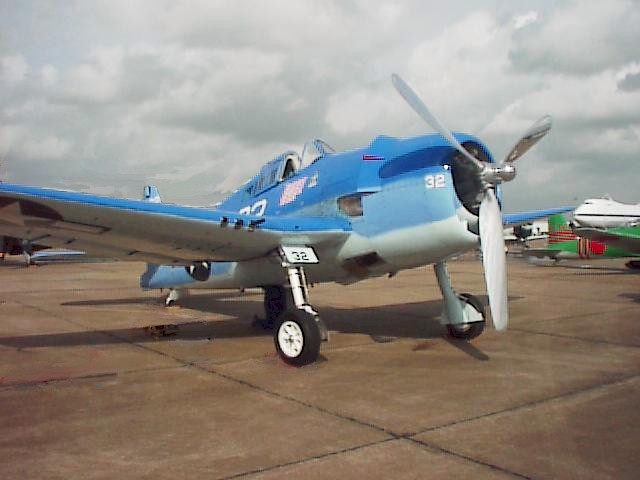The History of the F6F HellCat
Grumman F6F Hellcat
(Variants/Other Names: Gannet Mk I; Hellcat Mk I / Mk II)

Photo by Buck Wyndham, Copyright 1998
History: After early US Navy experience in the Pacific in the early months of WWII, and after consultation with Allied air forces in the European theater, Grumman began to develop a successor to their Wildcat fighter, to be called the Hellcat. Major design changes from the Wildcat included a low-mounted wing, wider landing gear which retracted into the wings, more powerful engine, improved cockpit armor plating, and increased ammunition capacity.
The Navy ordered four prototypes of the new airplane, each with a different engine for test and evaluation purposes. Less than a year later, on 26 June 1942, the first prototype (the XF6F-1, with a Wright R-2600 Cyclone engine) flew for the first time. Before much meaningful evaluation of the various engines could be made, however, the Navy decided to press the Hellcat into production by fitting the XF6F-1 prototype with the most powerful engine available, the Pratt & Whitney R-2800 Double Wasp. (This turned it into an XF6F-3. The XF6F-2 and XF6F-4 were never evaluated.)
The first production model, the F6F-3, first flew in October 1942, and deliveries began four months later with squadron VF-9 on the USS Essex in the Pacific. Extremely robust, powerful and maneuverable, the Hellcat was a potent force against the Japanese, and was credited with over three-quarters of the US Navy's air-to-air kills in the war.
The UK's Fleet Air Arm received 252 F6F-3s (designated Gannet Mk I) beginning in 1943. Meanwhile, in the US, over 200 Hellcats were modified as radar-equipped night fighters. During the F6F-3 production run, which lasted until April 1944, Grumman had developed an improved Hellcat, the F6F-5, which utilized a redesigned engine cowl, new ailerons, a strengthened tail, and a water-injection system for the engine, which added 10% to the takeoff performance and increased its armament-carrying capabilities. The F6F-5 was first flown on 4 April 1944, and production continued through November 1945. Over 900 more "Dash-5" Hellcats were delivered to the UK under the Lend-Lease program under the designation Hellcat Mk II.
Nicknames: Ace-Maker
Specifications (F6F-5):
Engine: 2000hp Pratt & Whitney R-2800-10W Double Wasp 18-cylinder
radial piston engine
Weight: Empty 9150 lbs., Max Takeoff 15,410 lbs.
Wing Span: 42ft. 10in.
Length: 33ft. 7in.
Height: 13ft. 6in.
Performance:
Maximum Speed at 23,500 ft: 380mph
Cruising Speed at 6,000 ft: 168mph
Ceiling: 37,300 ft
Range: 1,530 miles with 150-gallon drop tank
Armament:
Six 12.7mm (0.5 inch) wing-mounted machine guns
Two 1,000-lb bombs, or six 127mm (5-inch) rockets
Number Built: 12,275
Number Still Airworthy: 8
Links:
Aviation Enthusiast's Page: Hellcat
Combat Aircraft of the
Pacific War -- Hellcat
Dawn's Grumman Hellcat Shrine
Quonset Air Museum's
Ensign Frankwitz Memorial F6F-5 Hellcat
Flight Journal
magazine -- Hellcat Photo Essay
Photovault F6F Hellcat Photo Page
Zeno's Warbird
Videos Online -- "Flight Characteristics of the F6F Hellcat"